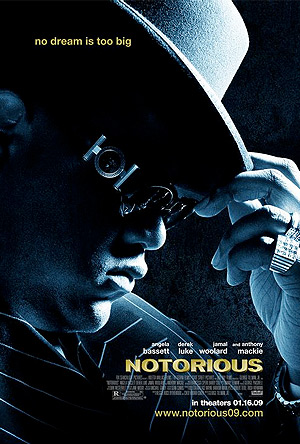 Notorious (2009, directed by George Tillman Jr. 100 minutes, U.S.)
Notorious (2009, directed by George Tillman Jr. 100 minutes, U.S.)
BY DAN BUSKIRK FILM CRITIC
Get a jump on mid-90’s nostalgia and catch the new biopic of slain hip-hop icon Biggie Smalls, Notorious. It’s 1994, George Foreman is the heavyweight champion, Tonya Harding and O.J. Simpson dominate the headlines. West Coast-based artists Tupac Shakur and Dr. Dre are at the top of the game when Sean “Puffy” Combs and The Notorious B.I.G. drop Biggie’s debut Ready To Die, drawing attention back to the rap game’s East Coast roots. Over the next few years this East Coast versus West Coast feud gets so hyped by the hip-hop media that within six months of each other in late ’96 both Tupac and Biggie, two of the biggest pop stars in the world, are shot dead by still unknown assailants.
It is such a juicy and unbelievable scenario it is surprising that it took this long for the story to hit movie screens. Soul Food director George Tillman Jr. has been off the scene since 2000’s Men of Honor and he never quite finds the rhythm to pull his rambling story together but we’re dealing with icons here and with a cast this lively Notorious can’t help but to channel some of the gleaming power of these superstar legends.
Unmissable at front and center is a debut performance Jamal Woolard, better known as the rapper Gravy, most famous for giving a interview to New York DJ Funkmaster Flex immediately after being shot in the ass (suspicions were never confirmed on whether it was actually just a crazy publicity stunt). Woolard was obviously hired for his size and his rap skills and if he never quite conjures the smooth rumbling bass-y tone of Biggie’s voice he does have the skills to bring some fire to the big musical set-pieces. It’s a pleasure to watch him change from wary mama’s boy to crack seller, drawn in by the Brooklyn streets (the young Biggie is actually played convincingly by the late rapper’s son, Christopher Jordan Wallace). Rapping on the street corners between sales, Biggie’s rep rises through the shady connections between the dealers and the record industry until he finally comes to the attention of ambitious upstart Sean Puffy Combs (the executive producer of the film) and together they climb to the top, up until Biggie’s murder four years later at the age of twenty-four.
Just like Biggie once rapped, it’s “Mo Money, Mo Problems” and its Biggie’s problems, namely wife Faith Evans (Antonique Smith) and long-time girlfriend Lil Kim (Naturi Naughton) that steal the show. Naughton’s Lil Kim in particular sets the film aflame with a frankly sexual performance that captures how shocking Kim’s act was at the time. It’s a great role and Naughton raps, humps, threatens and coos with such brio she runs roughshod over her man mountain co-star in each of their scenes. Anthony Mackie’s Tupac is begging for more screen time but he only makes occasional mercurial appearances, like a spectral presence sent to usher Biggie to his early grave.
It is always interesting to see how they conjure the atmosphere of a bygone era, especially one that passed only a dozen years ago. The production design doesn’t strain itself to bring the nineties to life, there’s some silly hats and garish sweaters that no pop star would be caught dead in today but mainly the look of nineties is shown to be glowing with rich candy-colored hues. It looks a little like a dream and compared to the decade that followed it just might have been. It certainly must have seemed like a dream comes true for Biggie, and despite the film’s pedestrian script it’s no small pleasure to see this talented Brooklyn fat kid live it out for a few fleeting years.
